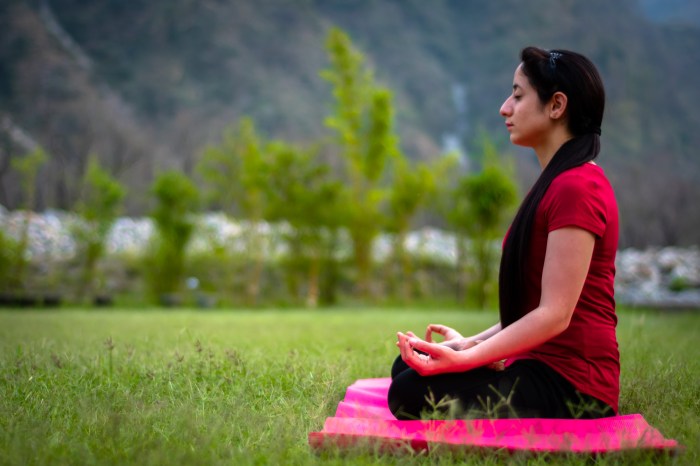Embark on a journey of self-discovery through the transformative practice of yoga meditation. Explore the profound benefits it offers for mental clarity, physical well-being, and inner peace.
Discover the various types of yoga meditation practices, delve into the art of mindfulness, and uncover the power of specific poses to elevate your meditation experience.
Benefits of Yoga Meditation

Source: wallpapercave.com
Yoga meditation offers a wide range of benefits for both the mind and body, promoting overall well-being and inner peace.
Improved Mental Clarity
- Regular practice of yoga meditation helps to clear the mind and enhance focus and concentration.
- It can improve memory retention and cognitive function, leading to better decision-making and problem-solving skills.
- By calming the mind and reducing mental clutter, yoga meditation allows for increased awareness and mindfulness in daily activities.
Physical Health Benefits
- Yoga meditation can help improve flexibility, strength, and balance through various poses and breathing techniques.
- It aids in the regulation of blood pressure, heart rate, and overall cardiovascular health, reducing the risk of chronic diseases.
- Regular practice of yoga meditation can boost immune function and promote better sleep patterns, leading to increased energy levels and overall vitality.
Stress and Anxiety Reduction
- One of the most well-known benefits of yoga meditation is its ability to reduce stress and anxiety levels by promoting relaxation and a sense of calm.
- Deep breathing exercises and mindfulness techniques can help individuals manage their emotions and reactions to stressful situations more effectively.
- Yoga meditation encourages self-awareness and self-compassion, fostering a positive mindset and reducing feelings of worry and tension.
Types of Yoga Meditation Practices

Source: indiaimagine.com
Yoga meditation encompasses various practices that cater to different needs and preferences. Each type offers unique benefits and techniques that contribute to overall well-being.
Hatha Yoga Meditation
Hatha yoga meditation focuses on physical postures (asanas) and breathing exercises (pranayama) to achieve a balance between mind and body. It is a gentle form of meditation suitable for beginners and emphasizes relaxation and flexibility.
Vinyasa Yoga Meditation
Vinyasa yoga meditation involves flowing sequences of poses synchronized with breath. This dynamic practice aims to build strength, improve flexibility, and enhance mental focus through continuous movement and mindfulness.
Kundalini Yoga Meditation
Kundalini yoga meditation focuses on awakening the energy at the base of the spine through repetitive movements, breathing techniques, chanting, and meditation. It aims to unlock spiritual potential and promote self-awareness.
Mindfulness Meditation vs. Yoga Meditation
While mindfulness meditation involves being present in the moment and observing thoughts without judgment, yoga meditation incorporates physical postures and breathing techniques to enhance mindfulness and promote holistic well-being. Yoga meditation combines the benefits of mindfulness with the added element of movement and breath control.
Specific Techniques in Yoga Meditation Practices
- Pranayama: Breathing techniques that help regulate breath and energy flow.
- Asanas: Physical postures that promote flexibility, strength, and balance.
- Mudras: Hand gestures that channel energy during meditation.
- Mantras: Sacred sounds or phrases repeated during meditation for focus and spiritual connection.
- Visualization: Mental imagery used to cultivate positive emotions and intentions.
Yoga Meditation Poses

Source: mindfulhappiness.org
When it comes to yoga meditation, choosing the right poses can significantly enhance your practice. Certain yoga poses help in calming the mind, improving focus, and promoting relaxation, making them ideal for meditation sessions. Here are some common yoga poses that are suitable for meditation:
Lotus Pose (Padmasana)
- The Lotus Pose is a classic meditation pose that helps in promoting a sense of calm and inner peace.
- It allows for proper alignment of the spine, helping you sit up straight and maintain focus during meditation.
- To achieve this pose, sit cross-legged with each foot placed on the opposite thigh, keeping the spine erect.
Easy Pose (Sukhasana)
- The Easy Pose is a simple cross-legged position that is comfortable for extended periods of meditation.
- It helps in grounding the body and calming the mind, allowing for a deeper meditation experience.
- Sit with your legs crossed and your spine straight, resting your hands on your knees.
Corpse Pose (Savasana)
- The Corpse Pose is a relaxation pose that is often used at the end of a yoga session or meditation practice.
- It promotes deep relaxation of the body and mind, helping you let go of tension and stress.
- Simply lie flat on your back with your arms by your sides, palms facing up, and close your eyes.
Tips for Maintaining Posture and Alignment
- Ensure your spine is straight and aligned throughout the practice to facilitate proper breathing and focus.
- Relax your shoulders and jaw to release any tension that may hinder your meditation experience.
- Find a comfortable seated position that allows you to relax while remaining alert and present.
Mindfulness and Yoga Meditation

Source: lalpathlabs.com
When it comes to mindfulness and yoga meditation, there are similarities and differences that are important to understand. Both practices focus on cultivating awareness and presence, but they do so in slightly different ways.
Comparison of Mindfulness Meditation and Yoga Meditation
- Mindfulness meditation typically involves sitting quietly and observing the thoughts and sensations that arise without judgment. It aims to develop a sense of inner peace and clarity.
- Yoga meditation, on the other hand, combines physical postures (asanas) with breathwork and meditation techniques. It integrates movement with mindfulness to achieve a state of physical and mental balance.
- While mindfulness meditation can be done independently of yoga, yoga meditation incorporates mindfulness into a broader practice that includes physical movement.
Integration of Mindfulness Techniques into Yoga Meditation Practices
- In yoga meditation, mindfulness techniques are often integrated into the practice through focused awareness on the breath during asanas and meditation.
- Practitioners are encouraged to stay present in the moment, observing their thoughts and sensations without attachment or judgment.
- By combining physical movement with mindfulness, yoga meditation helps individuals connect their mind, body, and breath in a harmonious way.
Benefits of Combining Mindfulness with Yoga Meditation
- Enhanced focus and concentration: The combination of mindfulness and yoga meditation can improve mental clarity and concentration.
- Stress reduction: Practicing mindfulness during yoga meditation can help reduce stress and promote relaxation.
- Emotional balance: By integrating mindfulness techniques, individuals can develop emotional resilience and regulate their responses to challenging situations.
End of Discussion

Source: elephantjournal.com
As we conclude this exploration of yoga meditation, remember that its harmonious blend of mindfulness and physical practice can truly enrich your life. Embrace this ancient discipline to nurture your mind, body, and spirit.